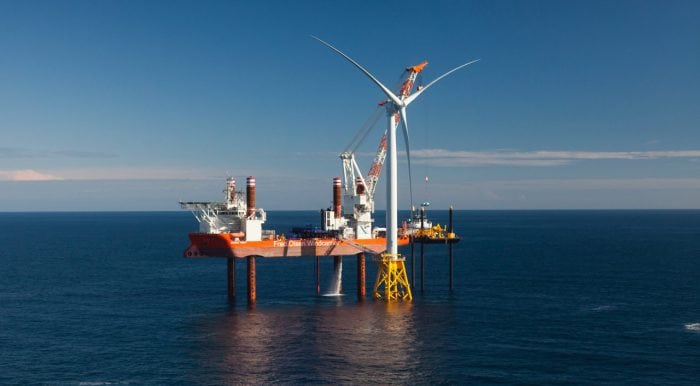Ørsted Offshore Wind Farms Delayed by Pandemic
Ørsted, the Denmark-based energy company and the world’s top
offshore wind developer, said at least five of its projects off the U.S. East
Coast could be delayed due to impacts from the coronavirus pandemic.
The company in an announcement April 29 said the projects, with total generation capacity of about 3 GW, could fall victim to a slowed permitting process caused by shutdowns due to COVID-19. Ørsted in a statement to investors said three large projects face “increased risk of delays,” including the 1.1-GW Ocean Wind installation off New Jersey; the 880-MW Sunrise Wind off New York; and the 704-MW Revolution Wind off Rhode Island.
The U.S. offshore wind industry has seen its growth stunted
by permitting issues and other regulatory delays, a situation now exacerbated
by the coronavirus. New York officials last week said the state’s plan to
procure as much as 2.5 GW of new offshore wind in its next solicitation is
being delayed past this summer due to the coronavirus pandemic.
Delays for Two Small Projects
Ørsted on Wednesday confirmed that two of the company’s smaller projects—the 120-MW Skipjack, off the Maryland coast, and the 130-MW South Fork off New York—in addition to the three larger wind farms, will almost certainly be delayed beyond their original 2022 completion dates. Ørsted in its statement said it expects to complete the Skipjack project in late 2023, and said coronavirus-related shutdowns in New York “will also very likely delay South Fork beyond 2022.”
The company said that for Skipjack, “it is no longer realistic to receive the ‘Notice of Intent’ from BOEM [Bureau of Ocean Energy Management] in due time to meet [the] commissioning date in late 2022.” Ørsted said that for the South Fork project, which was also planned to be commissioned in 2022, “we have received the ‘Notice of Intent’, but have not received a confirmed permit schedule from the federal government outlining when the ‘Construction and Operations Plan’ (COP) will be received. This combined with impacts from the COVID-19 related shutdowns in New York, will also very likely delay South Fork to beyond 2022.”

“Our offshore development projects in the U.S. are moving
forward, although at a slower pace than originally expected due to a
combination of the Bureau of Ocean Energy Management’s prolonged analysis of
the cumulative impacts from the build-out of U.S. offshore wind projects, and
now also COVID-19 effects,” Ørsted said in its statement. The BOEM oversees the
leasing of areas in federal waters for energy development.
Regarding the larger projects, Ørsted said, “We have
submitted our COP applications for Ocean Wind and Revolution Wind and are
awaiting BOEM to issue their ‘Notices of Intent’, outlining the timeline for
COP approval. For Sunrise Wind in New York, we are currently unable to progress
our offshore site surveys due to COVID-19 restrictions, which adversely impacts
our COP application process. So, for these three projects, we need more
visibility on the path to COP approval before concluding whether commissioning
in 2023-24 remains realistic. We expect to have more clarity after summer.”
CEO: No Risk to PPAs
Ørsted CEO Henrik Poulsen in a call with investors said the company does not at present see a risk to its power purchase agreements (PPAs) with the projects. Poulsen said the company still hopes to finish the three large projects on time in 2023-24.
“We are working to the same [commercial operation date]
schedule [for those projects], but we need to soon receive those permits … if
not there could be a delay, not necessarily a full-year delay,” Poulsen said.
“We don’t see any of the PPAs at risk; that’s not a concern for now.”
New England utility Eversource Energy owns 50% of the South
Fork, Revolution, and Sunrise Wind projects, in partnership with Ørsted. The
Long Island Port Authority also is part of the South Fork project. Ørsted is
building Ocean Wind in partnership with New Jersey utility PSEG. Turbines for
the five projects, including Skipjack, being built by Ørsted to serve the
Delmarva Peninsula, are being supplied by General Electric and Siemens Gamesa
Renewable Energy.
One Project in Operation
The nascent U.S. offshore wind market has several projects
in its pipeline, though only one installation—Block Island off Rhode Island, a
30-MW wind farm that was a POWER Top Plant in 2017—is in
operation. The offshore wind industry was dealt a setback in the past year with
the unexpected
permitting delay of what was touted as the first large-scale U.S. project,
the 800-MW Vineyard Wind development off Massachusetts, about 15 miles south of
Martha’s Vineyard.
Vineyard Wind LLC, the company developing Vineyard Wind project,
submitted its construction and operation plan to federal officials in December
2017, but the plan remains under review. The BOEM, despite delaying permits for
Vineyard Wind, has previously said it would make a final decision on the
project by year-end, but James Bennett, manager of the BOEM’s renewable energy
program, last week said the pandemic could alter that schedule.
Said Bennett: “We don’t anticipate any schedule slips just
yet. A lot of it will depend on how things work out with COVID and whether
we’re able to have the stakeholder involvement at the level that we’d like to.”
Bennett said the BOEM is in a “full telework arrangement right now” due to
shutdowns caused by the coronavirus.
—Darrell Proctor is associate editor for POWER (@DarrellProctor1, @POWERmagazine).